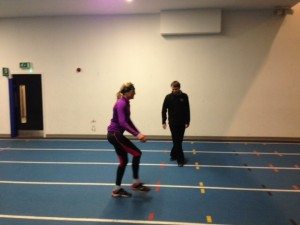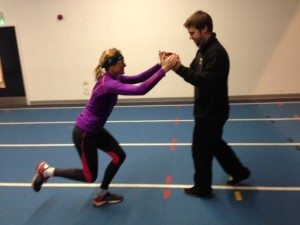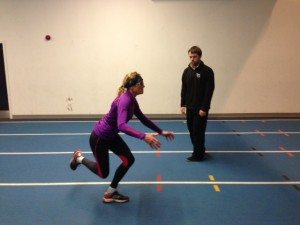How to run faster: Running gait analysis
I want to run faster. This will involve specific training sessions and a lot of hard work and determination. But I also wanted to be sure that my running gait is as efficient and useful as possible. So I put a request on Facebook looking for running gait experts in the Glasgow area. I was given many suggestions and chose Scott Devenney. This choice was fairly random but when we exchanged messages I immediately liked what he was saying.
 We met last week at Scotstoun track for an initial assessment.
We met last week at Scotstoun track for an initial assessment.
Running gait analysis
First, Scott asked me what my goals are. “To run faster and more efficiently,” I said, as I tried not to laugh at myself. Thankfully, Scott also managed not to laugh, even though he must have realised I’m almost twice his age and definitely not getting any younger. In actual fact, he seemed to take my goal very seriously.
At first, Scott didn’t want me to run. He wanted me to walk. I did as I was told and walked in a number of odd ways, for example, toes pointing inwards, up and down a short length of indoor track. I tried (again) not to snigger and feel self-conscious at the Ministry of Funny Walks . And, after a while, I relaxed and then Scott begin to give an assessment.
He said: “I usually wait until a client has done a few walks backwards and forwards. They always seem to force the walks and look stiff. After a while they relax and I can see their true gait.”
Almost immediately, Scott identified a problem. He said: “Your left hip seems less flexible and your leg has less mobility. Have you been injured?”
This is the leg with the long-term hamstring niggle. I have been struggling on with it for more than a year after pulling the muscle in a challenging cycling race. His assessment was spot on.
Lunges and squats
 Next Scott had me lunge-walking, lunge-twist-walking and then hopping. He got me to perform one-legged squats and to attempt all kinds of balance challenging exercises that revealed just how rubbish (my technical term!) my left side is at holding me upright.
Next Scott had me lunge-walking, lunge-twist-walking and then hopping. He got me to perform one-legged squats and to attempt all kinds of balance challenging exercises that revealed just how rubbish (my technical term!) my left side is at holding me upright.
According to Scott, while my right side does all the right things for running, including an “engaged glute”, my left side is all over the place and, in particular, my left glute is not engaging.
What this means is that and when I run for any distance more than a few miles, my glute is not assisting and so my hamstring is doing far too much work. Within a short distance, my hamstring starts to tire and it tightens with the overloaded work. (Scott, I hope I have this layman’s assessment fairly correct?!).
A correct running gait assessment
 Scott is entirely correct in identifying my weaker left side. My hamstring is always the first thing to tire and tighten when I run. When he got me to do squats and lunges, and other balance exercises, it became very clear that I am not using my glute to aid my running.
Scott is entirely correct in identifying my weaker left side. My hamstring is always the first thing to tire and tighten when I run. When he got me to do squats and lunges, and other balance exercises, it became very clear that I am not using my glute to aid my running.
Finally, Scott watched me as I ran at different speeds. He said my running style looks good. But he wonders how I would look after a few miles of hard running. This he will look at more closely at a later date.
My running gait exercise sessions
In the meantime, I have a set of “glute re-engaging” exercises to do. I am to practise them daily but not to the point of exhaustion. The exercises are all left side and the aim is to get the left glute to start triggering when I run. I have to remind it how to engage, apparently.
The exercises are challenging for now because I do not have an engaged glute. They will get easier, I am told.
The day after the assessment I could certainly feel that I had been engaging my glute. It was a little achy but not so bad that I was put off doing my exercises.
The exercises are boring but they should help. I will be practising the reps for a few weeks before I get back in touch with Scott for another assessment.
And something I have noticed is that if I do my glute engaging reps before a run, I seem to run more fluidly and with a more even left and right-sided running style.
My analysis of running gait analysis
In only an hour’s session I learnt a lot about how to improve my running gait, and what is working and not. Scott’s style is straightforward and explanatory. He doesn’t waffle and (kindly) tells you how you look and what your body is doing. He offers simple and clear instructions and sent me away with a good range of exercise sessions, but not so many that I feel confused and over-burdened.
He says he likes to tackle one stage/step at a time in rehabilitation and that makes a lot of sense to me.
He is calm, personable and seemingly very knowledgable. I took my triathlon coach, the Mighty Vickster, along with me to the session and she agreed that he “knows his stuff, especially his physical and sports science explanations and exercises”.
* Scott is a personal trainer and works from Pure Gym in Glasgow. He offers one-to-one sports and run gait sessions. Call him at: 07922 859106.
